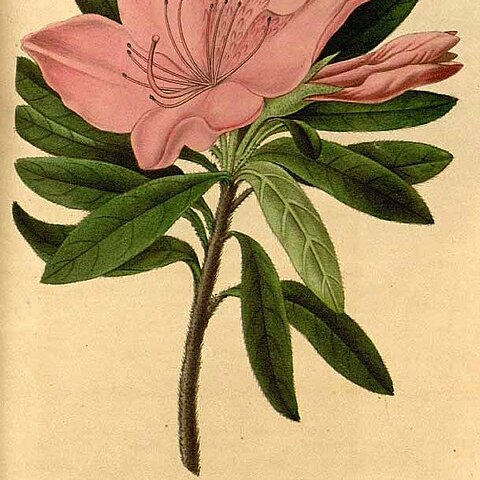Large shrubs or small trees, 1.5–8 m tall; old branches grayish brown, glabrous; young branches setose, rarely glabrous. Petiole 12–22 mm, sparsely blackish brown glandular-setose or glabrous; leaf blade leathery, oblong to obovate-oblong, 9.8–18 × 3.5–5.8 cm; base truncate to rounded; margin reflexed; apex acuminate; abaxial surface whitish green, midrib and base setose, other parts slightly hairy when young; adaxial surface green; midrib raised abaxially, impressed adaxially; lateral veins 17–21-paired. Inflorescence densely umbellate, 10–20-flowered; rachis ca. 5 mm, glabrous. Pedicel 0.5–1.3 cm, glabrous; calyx green flushed red, cupular; lobes 5, 7–15 mm, broadly ovate or obovate-oblong, glabrous or with base hairy; margin erose; corolla tubular-campanulate, fleshy, deep red to blood-red, 3.1–3.6 × 3–3.6 cm, with 5 deep blackish red nectar pouches at base, glabrous; lobes 5, ± rounded, ca. 1.8 × 1.6–1.8 cm, apex deeply emarginate; stamens 10, unequal, 1.3–2.1 cm, filaments white, glabrous, anthers subelliptic, purplish black, 1.6–2 mm; ovary cone-shaped, ca. 5 mm, densely short-glandular-hairy; style ca. 1.6 cm, glabrous; stigma small, reddish, ca. 1.8 mm wide. Capsule cylindric, ribs obvious, slightly curved, 20–24 mm, with vestigial glandular hairs; calyx persistent; style persistent. Fl. May–Jun, fr. Aug–Sep.
More
A large evergreen shrub. It can be a small tree. It grows 6 m high and spreads 6 m wide. The bark is smooth and dark red-brown. It peels off. The young shoots have long stiff bristles. The leaves are dark green and glossy. They are oblong and 20 cm long. They are dull green underneath. The flowers are bright red. They are fleshy and 8 cm long. They are in compact rounded groups. There can be 10-20 in a group.

